Dutch Blue & Blue Pied Peach faced Lovebirds
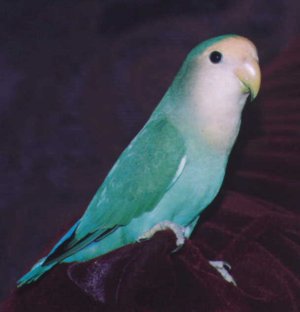 Blue Mutation of Peachfaced Lovebird
Blue Mutation of Peachfaced Lovebird
What a poser! Baby Blue is a tame beastie of mine, full-grown sibling to the lovebird babies shown below. Dutch Blue lovebirds take about a full year to reach their jewel-like bluish green coloring. These are not “true blue” birds like you get with Fischer’s – for this reason you won’t get an albino peachfaced lovebird (which is a blue-based bird) but you can get albino Fischer’s lovebirds.
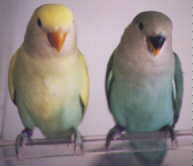
These are the babies of Remi & Winnie, their fifth clutch These babies were sweet as buttons, just like all of Remi & Winnie’s babies Remi & Winnie were babies raised by me, so their babies are my second generation babies.
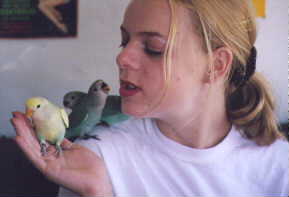
The wild-type coloring of peachfaced lovebirds is green. Blue is the “ground color” mutation – you can have many mutations that vary based on whether the bird is “green” or “blue”. Think of it as a branching genetic tree – with Green or Blue first, then you might have pied – blue pied or green pied, you might have a Blue American cinnamon or a Green American Cinnamon, et cetera. The ground color fundamentally affects everything when it comes to mutations.
You also have “factors” – such as Dark Factor and Violet Factor. The dark factor basically darkens the color of the bird. So a blue mutation with one dark factor would be called Medium Blue – if it had two dark factors it would be Slate (some people call this mauve).
Green Violet
Green violets are a normal wid-type green peachfaced lovebird with the violet factor, seen in the coloring of the rump.
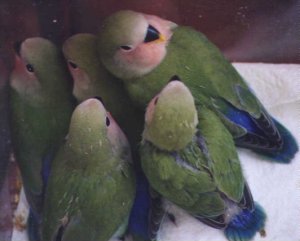
Babies take a while to get the full red face (about 1 year); this is another way to tell you have a young bird (see mature colors below).
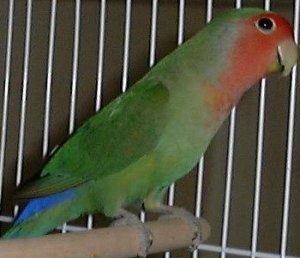
The violet factor gives the overall body color a deeper green tone with a bluish hue to it. The tips of the flight feathers are blue. The peachface is a deeper red, darkened as well by the violet factor.
It takes a year for the colors to develop completely. The rump is already a deep violet color, although it is difficult to truly catch this color in a photograph. I plan to keep some of these babies for future breeding since the color is just magnificent in my opinion. Below is an adult male. He is still molting slightly.
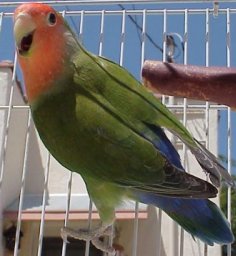
American Cinnamon





Violet Factor & Whitefaced Violet
There are great variations in the body color from one violet to another. It is the violet rump that shows the bird carries violet factor. Whiteface also can vary from a deep apricot band across the forehead to pure white mask. The hen below also has dark factors, giving her overall body a beautiful blueberry hue.

Here is a pair:

Pied violet is my favorite color variety of peachfaced lovebirds (from a whiteface violet cock and pied slate hen):

What a gorgeous kid in the above photo! The whiteface pied violet above is particularly beautiful, almost “clear” with very few pied markings on the back. The yellow with the violet undertones is incredible and will become more vibrant when the baby reaches full maturity in about 9 months. Here is a front shot of a very clear pied:


Here are some baby pics:





The parents are Valentino and Boomerang:
 |
 |
Australian Cinnamon & Orange-Faced Lovebirds

Matilda (above, left) is a green series Australian cinnamon hen. Her mate (to Matilda’s right) is an orange-faced lutino. Because these are both sex-linked mutations, I will know by the color of their babies what their sex is. All the Australian cinnamon babies will be males and all the lutino babies will be hens.

Australian cinnamon birds have ruby-colored eyes (this can fade quite a bit as they mature, but is very distinctive in babies).

The lutino is a red-eyed mutation. The orange-faced mutation is STILL part of the peachfaced lovebird species – it is only a color mutation of that species.
Matilda’s mask has still not completely colored out. She is about 7 months old here.
Now the above birds are what are called “green series” mutations. If you have these same mutations in “blue series” mutations, they express themselves different, per the pictures below.
Sydney (below) is a blue series Australian cinnamon. She doesn’t have any color in the face. The color you see (the slight orange) is just some color that came off her swing (food coloring).
Below is another photo of Sydney, the blue series Australian cinnamon hen. She is a baby in these three photographs (less than 3 months old) and her color has not fully developed.
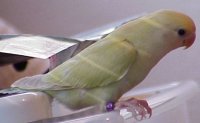
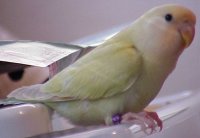
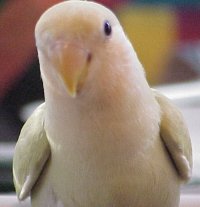
“Cobalt” – Slate, Double Dark Factors
Cobalt with double violet factor (blue series) peachfaced lovebird
Mom: American Cinnamon Violet Peachfaced Lovebird
Dad: Slate Peachfaced Lovebird

This lovebird baby’s mom is the cousin of Buttercup’s mom. The baby’s dad is a whiteface slate with only a hint of the apricot band. They had three babies like this, and one that is a lovely pale American Cinnamon Seagreen violet. Their last clutch were all American cinnamon violets.

What is a slate? A slate is blue series bird that has a double dark factor. It can be a very dark bird and the body can range from a deep green to an almost grey color. The rump is deep grey.

This is an adult male of the parents above. He is a cobalt violet. The picture is a bit too dark to truly show his colors.
What is cobalt? Cobalt is another way of saying a blue series lovebird with a dark factor. This deepens the body color considerably. You can still see the violet in the rump.

A violet is determined by the violet rump. Therefore, a violet lovebird’s body color can range dramatically from a greenish blue to a deep grey-green, depending on such genetic factors as dark factors etc
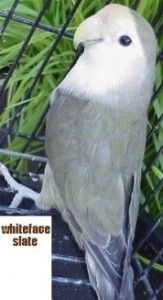
Below: American cinnamon baby from Delilah and Storm. Born April 2000. Below that is a picture of a sibling who is cobalt violet. Both photos taken May 2000.
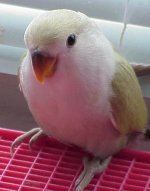
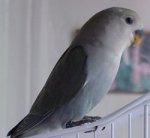
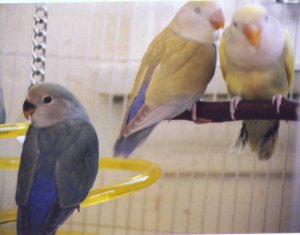
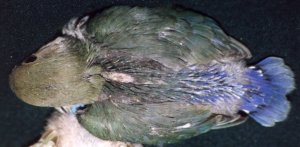
Fischer’s Mutations: Albino, Lutino, Yellow, White

Fischer’s lovebirds are a completely different species from Peachfaces. These birds also come in a variety of colors, from the wild-type green to the dramatic lutino and captivating albino.

I have found these birds to be extremely gentle, even if they haven’t been handled regularly. If you want a pet it is still best to get a handfed baby that has been well-socialized. However, I have found many Fischer’s easier to tame again if they’ve been allowed to “go wild,” unlike most peachfaces.

Tundra (albino) and Tequila (lutino) are stunning Fischer’s lovebirds – nicknamed TnT!
Yellow Fischers (Green Series – Split Ino)


White Mutations:



